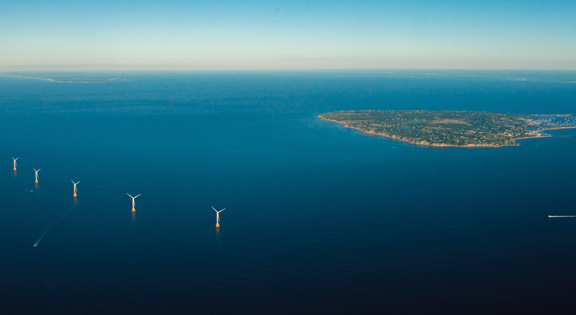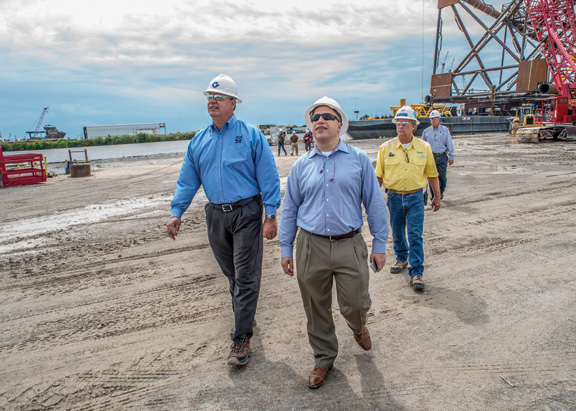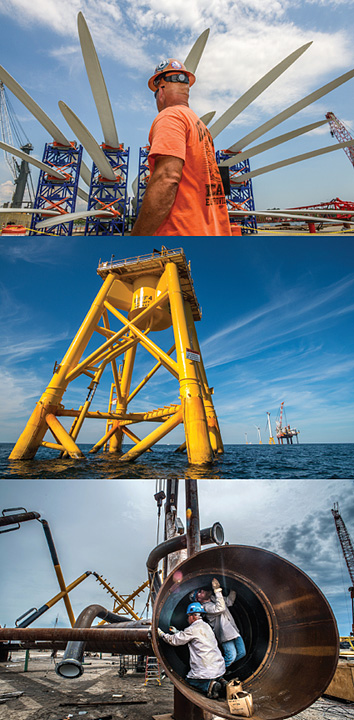On December 12, 2016, the Block Island Wind Farm—North America’s first offshore facility for generating electricity from wind—went fully operational. It was a little cold for ribbon cutting or smashing champagne bottles, but a small corner of Twitter blew trumpets. Jeff Grybowski ’93, CEO of Deepwater Wind and the visionary behind this breakthrough achievement, kept a low profile that day.

For Grybowski the true milestone had been on August 18, when the Brave Tern, a ship built in Dubai for exactly this purpose, had lifted and secured the last turbine blade on Tower Five. That day had been the culmination of seven years of hard work that included lawsuits and enough hearings to secure twenty-one local, state, and federal permits. There had been endless studies and innumerable planning and design revisions. Finally, in 2015, steel had gone into the water: 1,500 tons of it for each of the five turbine platforms, or jackets. Each jacket was essentially nailed to the sea floor by 200-foot lances of pile-driven steel and a 400-ton steel tower affixed on top. Then came 450 tons of turbine, each fitted with three twenty-four-ton blades. It might seem like Tinker Toy construction, everything fabricated on land and snapped together on site. But at that scale, at sea, with all those moving pieces, it was enough to keep any CEO awake at night.
Today, standing nearly 600 feet tall, these windmills are so large that even Don Quixote would have thought twice. But Grybowski dreams even bigger. Although the Block Island Wind Farm generates enough power for 17,000 homes, in his view it’s just a demonstration project, a proof of concept. If it is the only project Deepwater Wind builds, Grybowski believes he will have failed. His vision is nothing short of reinventing how power is generated on the eastern coast of the United States.
On September 11, 2001, in his apartment two blocks south of the World Trade Center, Grybowski awoke to the sound of American Airlines Flight 11 hitting the North Tower. He had been planning to leave New York City and had left his job just a few weeks before to savor the city for a month. He was returning to his home state, back to Providence to join the firm of Hinckley Allen & Snyder in October.
“The crash of the plane woke me up. Then I heard the second plane crash and saw people running down the street,” he recalls. He hurried to the lobby of his building, stepped out, and saw the gaping hole in the South Tower. Rushing back upstairs to grab a few things, he heard “the loudest rumble I’ve ever heard in my life.” Then his window went dark. The fire alarms kicked in, and he left his apartment at a run.
Back in the lobby, firemen were taking temporary refuge from the worst of the debris cloud. When civilians were finally cleared to leave, Grybowski turned away from Ground Zero and started walking. Then he heard the second tower collapsing and began to run. “I didn’t stop running until I reached the waterfront and jumped on the Staten Island Ferry,” he says.
Forty-eight hours later he was in Rhode Island, where he settled into the life of a young corporate law associate. In 2002 a senior partner who knew he was interested in politics introduced him to Don Carcieri ’65, a Republican who was then running an outsider’s campaign for the governor. One thing led to another, and Grybowski became Carcieri’s chief of staff during his first of two terms.
In January 2006, the Carcieri administration began to study how it might generate 15 percent of its electricity from local wind power. Grybowski says he doesn’t recall much about the establishment of the RIWINDS program. “Wind reports weren’t really on my radar,” he says. At the end of 2006 he returned to his law firm, now a partner.

Although offshore wind had by then become established in Europe, no one had ever built an offshore wind farm in the United States. Getting approval would be a regulatory riddle, and Grybowski was entrusted with solving it. The complications, which involved business, law, regulation, and construction, were enormous. “Before long,” Grybowski says, “I was doing far more than just legal work.” Deepwater Wind became his biggest client.
European wind development had started with small projects in the 1990s, and in 2001 the projects started getting bigger. By 2007 Europe’s turbines were generating 10 percent more electricity than was needed to power all of Rhode Island. As Grybowski watched, construction surged—between 2007 and 2010 European wind capacity nearly tripled; it quadrupled again between 2010 and 2016. Meanwhile, the U.S. energy market was also changing: from Maryland to Maine, every coastal state mandated that a percentage of its power come from renewable sources. Federal legislation in 2005 and 2007 also provided incentives for renewable-energy production.
By 2010 Grybowski had become so involved with Deepwater Wind that he became the logical choice for CEO. “I had an opportunity to be there in the very beginning,” he says, “and help shape the future of how we produce electricity in this part of the country. That was frankly too good an opportunity to pass up.”
To Grybowski, offshore wind was an opportunity to evolve beyond New England’s antiquated power-generation infrastructure. In 2000, three sources accounted for more than two-thirds of the region’s electricity: nuclear, oil, and coal, in that order. By 2014 natural gas was emerging and oil had dropped to only 1 percent, with coal at five. On May 31, 2017, the contribution of coal will drop even further when Brayton Point Station, the last coal-fired generator in Massachusetts, is shuttered, and nuclear energy production will drop in 2019, when Pilgrim Nuclear in Plymouth will be mothballed. In all, between 2012 and 2020 almost 15 percent of New England’s current generating capacity will shut down permanently while demand will continue to rise.
“Infrastructure has a life cycle, and power generation in the Northeast is far past its prime,” says Grybowski. “It’s a challenge, but it’s also an opportunity, because the plants need to be replaced with something. We need to continually reinvent our power system.”
In other parts of the country, solar and wind have grown increasingly competitive with fossil fuels. But infrastructure development on any scale is a challenge in the densely populated Northeast, and substantial onshore wind and solar installations require a lot of land. Traditional power plants are even more difficult to build because of environmental concerns around the transportation and burning of fossil fuels. New natural gas plants are cleaner and more efficient than coal, but pipelines and compressed natural gas terminals aren’t an easy sell to neighbors. Nuclear is politically taboo.
Meanwhile, some of the strongest winds in the hemisphere blow consistently off the eastern seaboard. Offshore wind can produce a large amount of new, clean energy, close to population centers, and with almost no footprint. Much of it won’t even be visible from land. “Market forces are compelling folks to look at offshore wind as a very serious part of the new energy portfolio,” says Grybowski.
Despite general public support and the Carcieri administration’s enthusiasm for wind, not everybody in Rhode Island was on board. In 2010 two of the state’s largest manufacturers challenged the power-purchase agreement between Deepwater Wind and National Grid on economic grounds. Block Island Wind Farm electricity would be about three times more expensive than electricity from conventional sources, leading to what they argued was an unreasonable overall rate hike of 2 percent.
Although the agreement was ultimately upheld by the state supreme court, Grybowski acknowledges that new technologies always look expensive compared to the existing ones. And as a small project, the Block Island Wind Farm is unable to take advantage of economies of scale. The undersea structures were built on the Gulf Coast, while the blades, turbines, and towers were imported from Europe. Specialized boats and experienced workers also had to be brought over. In effect these are start-up costs, Grybowski argues, that will come down as the industry takes hold domestically. A primary hope of Rhode Island’s wind-energy program is that it will spur in-state manufacturing of platforms, towers, and perhaps even turbines.
“The cost per megawatt—which is how our markets work, and how customers respond—is the most expensive except for new nuclear,” explains Bonnie Ram, an offshore wind expert from the Center for Carbon-Free Power Integration at the University of Delaware. “We still have to deal with those questions.”
Complicating the economics has been the rapid rise of cheap natural gas—between 2000 and 2017 it jumped from producing 18 percent of New England electricity to 45 percent. Nevertheless, Massachusetts, preparing for a major investment in offshore wind, commissioned the University of Delaware’s Special Initiative on Offshore Wind to look at the issue of costs. The report projects that they will be “far lower than previously contracted prices for offshore wind in the New England region” and that the price tag will keep going down as capacity expands. And it’s not just the usual suspects making these arguments. Oil giants Shell and Statoil have made heavy regional investments in offshore wind. “There are market forces driving the development of new energy resources across the world, but it’s happening in spades here in the Northeast,” Grybowski observes. “This is a good piece of infrastructure that we ought to be building.”
By emphasizing the economic argument for wind power, Deepwater Wind sidesteps the partisan deadlock over climate change. But Grybowski doesn’t hide his concern. “Climate change is one of the principal challenges of our age,” he argues. “We need to work together to find solutions, and to begin to plan for what increasingly seems to be some inevitable level of climate change. It’s a big, serious problem, and we need to address it seriously and collectively. Changing our energy system is one principal way to do that. If we’re successful we will have done our part on the climate issue.”

Earlier this year the turbines sailed through ferocious New England winter windstorms, though the blades are stopped in extremely high winds. To remain viable, Grybowski acknowledges, the Block Island Wind Farm and offshore sites like it will have to withstand the force of events like 2012’s Hurricane Sandy. The mind-bending variables include wave size, rising sea levels, the frequency of large storms, and the strength of the wind over time.
The typical design standard requires that a turbine withstand a thousand-year storm. That’s daunting enough until you realize that we don’t live in average times, and the thousand-year standard has been changing along with the weather. “The thousand-year storm that we predict today is different from the thousand-year storm that we would have predicted ten years ago,” Grybowski explains. “And the frequency of extreme weather events is higher.”
The Block Island Wind Farm was still on the drawing board when Hurricane Sandy came up the East Coast. “It makes it very real,” says Grybowski. “I need to be able to tell investors and banks and regulatory agencies and the community that what we’ve built can withstand these extreme events.”
For much of the twenty-first century, the Block Island Wind Farm wasn’t expected to be first to the finish line. The favorite was Cape Wind, a controversial 2001 proposal for Nantucket Sound about sixty miles to the east. But despite securing regulatory approval, siting a large project in the view of a major vacation destination ultimately proved too unpopular with the public.
“It wasn’t until fairly recently that people stopped confusing our company and our project with Cape Wind,” Grybowski says. But the troubles on the Cape emphasized how much scrutiny alternative-energy companies face. Two of the more scandalous corporate failures in recent history involved alternative energy: the collapse of Enron—which started out as a wind company—and the disastrous solar startup Solyndra, which lost a half-billion dollars of federal funding, giving the Obama Administration a major black eye along the way.
Locally, the dynamic is different. Given Rhode Island’s long history of ethically challenged deal-making, Carcieri’s support for a project now run by his former chief of staff looked dubious to some early critics. But despite some difficulties—building the wind farm took four years longer than anticipated—the Block Island Wind Farm has become a model for offshore wind advocates precisely because of the government’s positive role.
It has also drawn little local opposition. Block Island residents largely supported the project because it should lower electric rates by connecting them to the grid. It has also provided high-speed Internet and cable. Potential resistance was also disarmed by a planning process that surveyed a variety of offshore resources. “You look out [at the ocean] and you don’t see much, but there is a lot of activity,” says Grover Fugate, director of the RI Coastal Resources Management Council. The sea floor, the water column, the surface itself, the air above it—every surface is in use in some way, at some time. The uses change by the season, and even over time. “It is a very complex and busy place,” Fugate says.
Deepwater Wind, says Fugate, seemed to understand the benefit of rigorous review. “They gave us room and backed off to let us do our job,” he says. The Special Areas Management Plan (SAMP) included input from such interested parties as Native Americans and local fishermen. “We had no preconceived notions,” says Fugate. “We were letting the science drive the sorting process.” This winnowing won the support of most of the major user groups and participating agencies.
The area ultimately designated for wind development preserved such things as traditional fishing areas. By the time the final draft went through public hearings, the three major state fishing organizations, the Conservation Law Foundation, and the Narragansett Indian Tribe all supported it, along with a vast majority of people who attended public hearings. “I can assure you that would never have happened without the SAMP being in place,” Fugate says.
“Jeff is a pioneer,” the University of Delaware’s Bonnie Ram says of Grybowski. Ram, who’s been watching the business closely for nearly two decades, says that getting the Block Island Wind Farm operational is a “miracle.”
And she is most curious to see what happens next, as forces align for what could be a major revolution in the American power industry. The federal government now has eleven active offshore wind leases along the eastern seaboard. Massachusetts has committed to 1.6 gigawatts of wind generation over the next ten years, and New York wants 2.3 gigawatts by 2030.
Federal support may not be as strong as it was during the Obama Administration. President Trump spent a lot of his campaign promising to revive the coal industry and is on record as disliking the offshore wind turbines visible from his golf courses in the United Kingdom. But, in a February radio appearance, Grybowski was optimistic. “I think that the Trump Administration is going to come to see wind, both onshore and offshore, as a great economic engine,” he argued. “There are a hundred thousand Americans working in the wind industry in the United States.” Indeed, according to the Bureau of Labor Statistics, wind turbine service technician is on track to being the fastest-growing job in the United States.
“This is going to be a critical time,” Ram says. “The cost issues are real and can only be mitigated by scale. You can see the pipeline evolving, and I think Deepwater Wind is going to be a player.”
In January, Deepwater Wind took the pole position in the race, winning its second contract, this time from the Long Island Power Authority to build a 90-megawatt offshore wind farm, three times the size of the Block Island project. Proving that offshore wind can be an economically viable option, the proposal beat out one from a natural-gas generator on a cost basis.
If the area of that lease is fully built out, it will eventually contain some 200 turbines, enough to power half a million homes. “The Block Island Wind Farm is the key to opening up this industry,” Grybowski says. “It demonstrates to important partners like utilities and governmental agencies that these projects can be built, they can produce energy. Thanks to its success, we’re seeing this market open up greatly.”
“For an economy that has a long tradition in marine industries and marine science, Rhode Island is a great place to kick off that industry,” Grybowski argues. “We’re anxious to move on to what’s next.”
Erik Ness is an environment and science writer based in Madison, Wisconsin.





